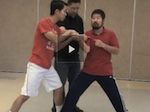The original verse is “That with shape and odor is an illusion; that without is the real thing.” I intentionally changed it to: “That with shape and odor is an illusion; that without could be real.” to:
- To see if people notice the change.
- To see if people notice the difference between the logic of the two different verses.
In our daily taiji life, we are often told, “It is not this, it is THAT!” This has been used to cover up for many of the problems in taijiquan such as in the case when the form is very bad the person will say “It is the internal aspect, not the form that matters,” “Taiji has no forms, if there is, it is empty.”
In serious taiji learning, one must first of all make sure that the form is present and is done according to the rules. Only after that one can talk about the internal aspect of the form.
This is very important in our taiji learning. When we are told to do something, it does not automatically mean something else that is similar and vice versa.



{ 4 comments… read them below or add one }
Contained spiral force – Internal energy flows through rotation and spiral of bone structure and joints that is not quite obvious. If you can see it from outside, probably it is tossing.
Very “ZEN”.
This reminds me of the first chapter of the Tao Te Ching.
Shape and odor are an illusion because they are a description of something. They are not the thing itself. There can be many descriptions of any one thing. A description can be based on the perspective of the person making the description or on the relation of one thing to another.
I once went with a friend to visit his parents. As we got close we drove through some farm land. I did not like the smell of the cows as we drove by. My friend, however, was comforted by the smell, since it was familiar and held good memories of the area for him. Our descriptions of the smell were different, but it was just the smell of cows.
If I stand next to me mother and sister, I am tall. If I stand next to my father and brother, I am short. Am I tall, or am I short? I am neither. I am 5 foot 10 inches.
I think the Tai Chi Principles 1 Online Video touches on this very well. We want to learn and understand Yin Yang Split. Once we understand Yin Yang Split, we use other methods to verify that we are doing it properly. Consistency and rotation are the two described in the video.
“You get one; it is the other.”
“Split is consistent is rotation.”
We need to understand and work on the principle. On more than one occasion during the seminar in Edmonton, Master Chen told us something we needed to do, but that we needed to figure out how to do it. If there is too much description, the we are following the description rather than the principle to which the description points.
The reflection of the moon in the lake is not the moon. Looking at the moon is not the moon.
“is the real thing” in the original verse
vs.
“could be real” in the revised verse
This makes a huge difference where one thing is considered to automatically follow the other (as if the flip-side of the same coin)
vs.
one thing may follow (or be true) but is not necessarily so (not necessarily a product of; or is not necessarily connected/ not necessarily the flip-side of the coin)
I remember Master Chen, in a workshop, saying something along the lines of:
‘If you follow what everyone else does, you’re sure to be wrong’
‘If you do your own thing, you may be right, you may be wrong’
he could have said:
‘If you do your own thing, you will be right’
or
‘If you do your own thing, you will be wrong’
but there’s no guarantee that one follows from the other, or that you automatically have an answer to something else.
(I believe the above was mentioned in relation to the Taoist principle of “There is one right and unlimited wrong”)
In class or workshops I’ve seen this thinking occur many, many times (by others and myself). For example, when Master Chen gives a simple instruction and the mind races to “well that means this, this, this and this”. When we think this way, it seems to me that our minds are taken away entirely from the very point itself.